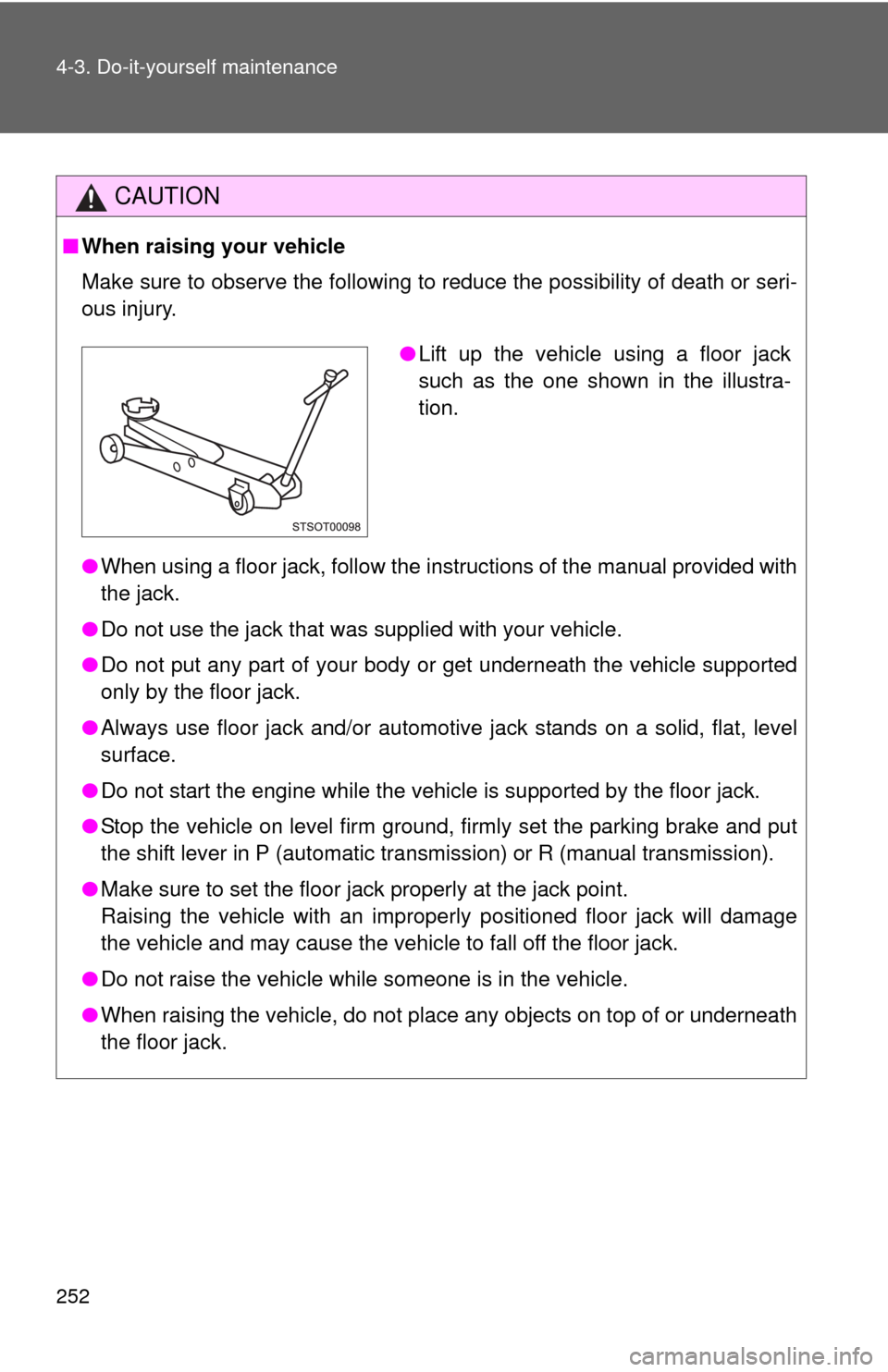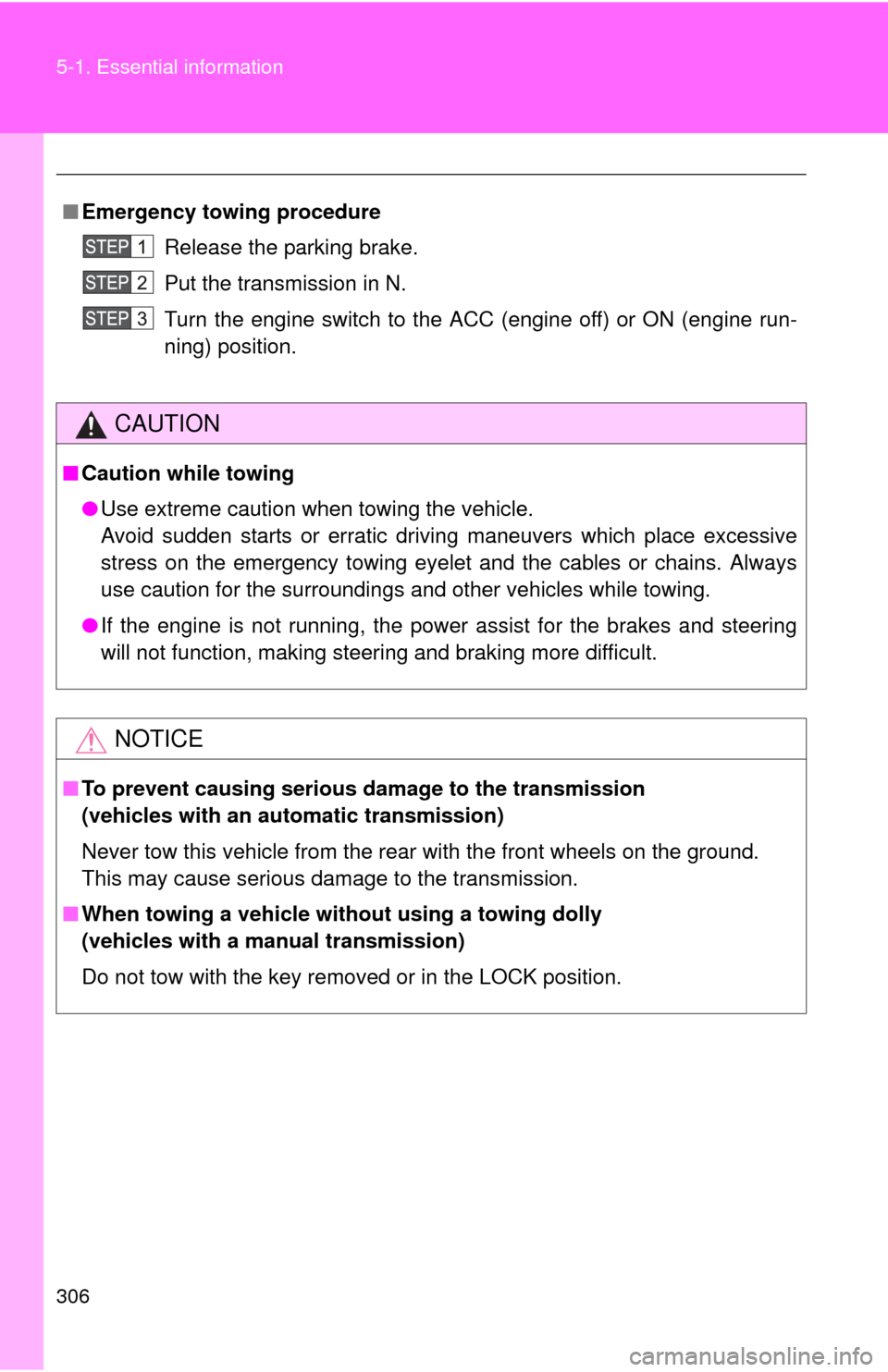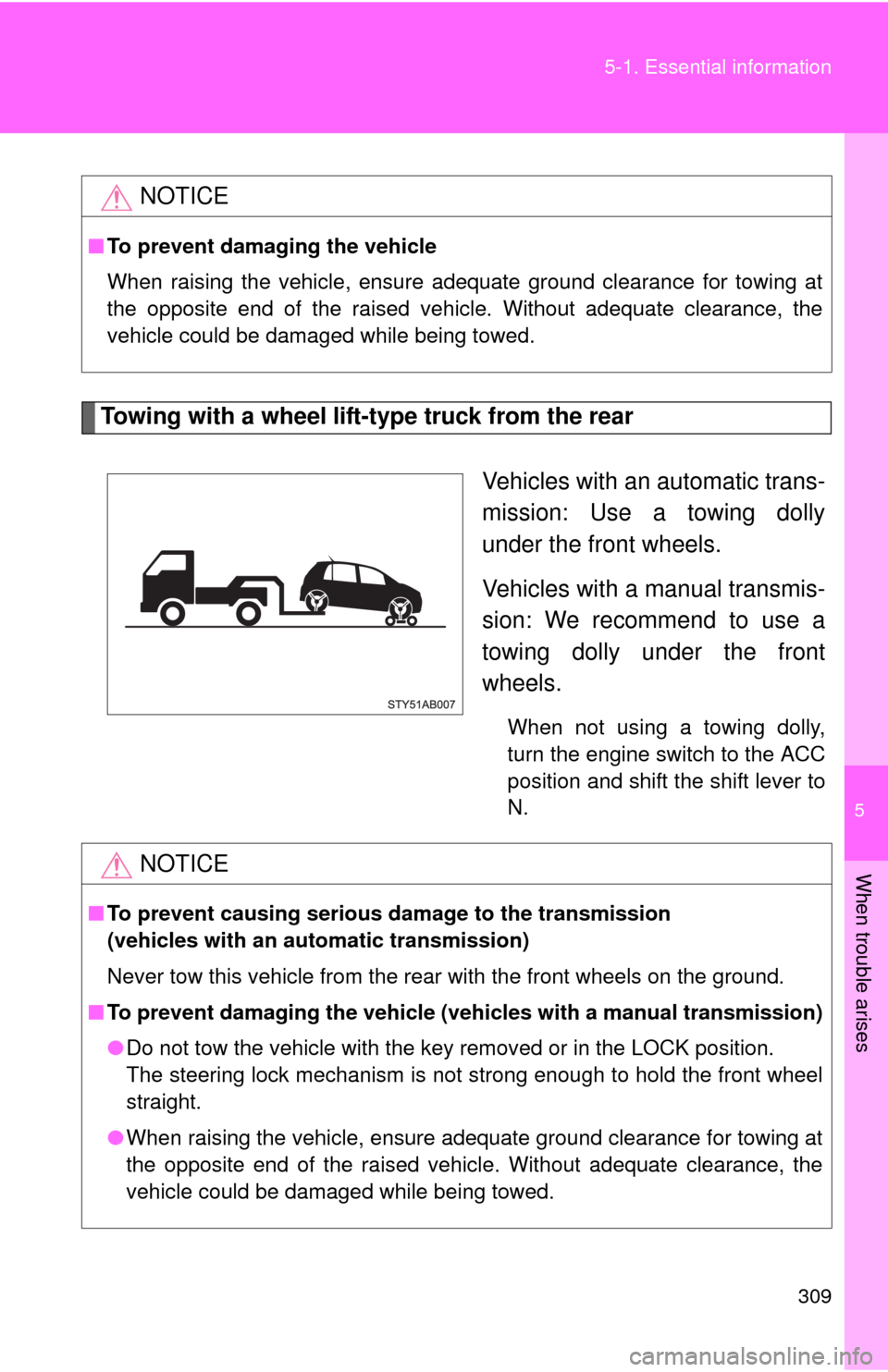Page 252 of 400

252 4-3. Do-it-yourself maintenance
CAUTION
■When raising your vehicle
Make sure to observe the following to reduce the possibility of death or seri-
ous injury.
●When using a floor jack, follow the instructions of the manual provided with
the jack.
●Do not use the jack that was supplied with your vehicle.
●Do not put any part of your body or get underneath the vehicle supported
only by the floor jack.
●Always use floor jack and/or automotive jack stands on a solid, flat, level
surface.
●Do not start the engine while the vehicle is supported by the floor jack.
●Stop the vehicle on level firm ground, firmly set the parking brake and put
the shift lever in P (automatic transmission) or R (manual transmission).
●Make sure to set the floor jack properly at the jack point.
Raising the vehicle with an improperly positioned floor jack will damage
the vehicle and may cause the vehicle to fall off the floor jack.
●Do not raise the vehicle while someone is in the vehicle.
●When raising the vehicle, do not place any objects on top of or underneath
the floor jack.
●Lift up the vehicle using a floor jack
such as the one shown in the illustra-
tion.
Page 306 of 400

306 5-1. Essential information
■Emergency towing procedure
Release the parking brake.
Put the transmission in N.
Turn the engine switch to the ACC (engine off) or ON (engine run-
ning) position.
CAUTION
■Caution while towing
●Use extreme caution when towing the vehicle.
Avoid sudden starts or erratic driving maneuvers which place excessive
stress on the emergency towing eyelet and the cables or chains. Always
use caution for the surroundings and other vehicles while towing.
●If the engine is not running, the power assist for the brakes and steering
will not function, making steering and braking more difficult.
NOTICE
■To prevent causing serious damage to the transmission
(vehicles with an automatic transmission)
Never tow this vehicle from the rear with the front wheels on the ground.
This may cause serious damage to the transmission.
■When towing a vehicle without using a towing dolly
(vehicles with a manual transmission)
Do not tow with the key removed or in the LOCK position.
Page 309 of 400

5
When trouble arises
309 5-1. Essential information
Towing with a wheel lift-type truck from the rear
Vehicles with an automatic trans-
mission: Use a towing dolly
under the front wheels.
Vehicles with a manual transmis-
sion: We recommend to use a
towing dolly under the front
wheels.
When not using a towing dolly,
turn the engine switch to the ACC
position and shift the shift lever to
N.
NOTICE
■To prevent damaging the vehicle
When raising the vehicle, ensure adequate ground clearance for towing at
the opposite end of the raised vehicle. Without adequate clearance, the
vehicle could be damaged while being towed.
NOTICE
■To prevent causing serious damage to the transmission
(vehicles with an automatic transmission)
Never tow this vehicle from the rear with the front wheels on the ground.
■To prevent damaging the vehicle (vehicles with a manual transmission)
●Do not tow the vehicle with the key removed or in the LOCK position.
The steering lock mechanism is not strong enough to hold the front wheel
straight.
●When raising the vehicle, ensure adequate ground clearance for towing at
the opposite end of the raised vehicle. Without adequate clearance, the
vehicle could be damaged while being towed.
Page 325 of 400
5
When trouble arises
325
5-2. Steps to take in an emergency
If you have a flat tire
Remove the flat tire and replace it with the spare provided.
■Before jacking up the vehicle
●Stop the vehicle on a hard, flat surface.
●Set the parking brake.
●Shift the shift lever to P (automatic transmission) or R (manual
transmission).
●Stop the engine.
●Turn on the emergency flashers.
■Location of the spare tire, jack and tools
Spare tire Jack
Jack handle
Tie-down belt
Tool bag
(including towing
eyelet)
Page 344 of 400

344 5-2. Steps to take in an emergency
CAUTION
■Battery precautions
The battery contains poisonous and corrosive acidic electrolyte, while
related parts contain lead and lead compounds. Observe the following pre-
cautions when handling the battery.
●When working with the battery, always wear safety glasses and take care
not to allow any battery fluids (acid) to come into contact with skin, clothing
or the vehicle body.
●Do not lean over the battery.
●In the event that battery fluid comes into contact with the skin or eyes,
immediately wash the affected area with water and seek medical attention.
Place a wet sponge or cloth over the affected area until medical attention
can be received.
●Always wash your hands after handling the battery support, terminals, and
other battery-related parts.
●Do not allow children near the battery.
NOTICE
■To prevent damaging the vehicle (vehicles with a manual transmission)
Do not pull- or push-start the vehicle, because the three-way catalytic con-
verter may overheat and become a fire hazard.
■When handling jumper cables
Be careful that the jumper cables do not become tangled in the cooling fan
or any of the belts when connecting or disconnecting them.
Page 348 of 400
348
5-2. Steps to take in an emergency
If the vehicle becomes stuck
■Emergency hook
Carry out the following procedures if the tires spin or the vehicle
becomes stuck in mud, dirt, or snow.
Stop the engine. Set the parking brake and put the shift
lever in P (vehicles with an automatic transmission) or N
(vehicles with a manual transmission).
Remove the mud, snow, or sand from around the stuck tire.
Place wood, stones or some other material to help provide
traction under the tires.
Restart the engine.
If equipped, turn off the VSC (P. 161)
Shift the shift lever to D or R (automatic transmission) or 1
or R (manual transmission) and carefully apply the acceler-
ator to free the vehicle.
When your vehicle becomes stuck and
cannot move, the emergency hook is
used for another vehicle to pull your vehi-
cle out in an emergency.
Your vehicle is not designed to tow
another vehicle.
Do not use the left rear hook. It is not
designed for towing.
Page 356 of 400
356 6-1. Specifications
How to read oil container label:
The ILSAC (International Lubricant Standardization and Approval
Committee) Certification Mark is added to some oil containers to help
you select the oil you should use.
Cooling system
Ignition system
CapacityVehicles with an automatic transmission
5.0 qt. (4.7 L, 4.1 Imp.qt.)
Vehicles with a manual transmission
5.1 qt. (4.8 L, 4.2 Imp. qt.)
Coolant typeUse either of the following.
• “Toyota Super Long Life Coolant”
• Similar high-quality ethylene glycol-based
non-silicate, non-amine, non-nitrite and
non-borate coolant with long-life hybrid
organic acid technology
Do not use plain water alone.
Spark plug
Make DENSO
NGKSK16R11
IFR5A11
Gap 0.043 in. (1.1 mm)
Page 393 of 400

393 Alphabetical index
Luggage compartment features
Auxiliary boxes ..................... 233
Luggage cover...................... 234
Luggage compartment light
Wattage ................................ 360
Maintenance
Do-it-yourself
maintenance ...................... 247
Emission inspection and
maintenance (I/M)
programs ............................ 246
General maintenance ........... 243
Maintenance data ................. 352
Maintenance requirements ... 241
Vehicle exterior..................... 236
Vehicle interior...................... 238
Manual transmission
Manual transmission ............ 134
Oil ......................................... 358
Meter
Instrument panel light
control ................................ 143
Meters .................................. 139
Mirrors
Inside rear view mirror ............ 67
Side mirror heaters ............... 193
Side mirrors ............................ 68
Vanity mirrors ....................... 228
MP3 disc................................... 208
Noise from under vehicle ......... 20
Odometer ................................. 142
Oil
Engine oil.............................. 254
Manual transmission ............ 358
Warning light ................ 316, 318
Opener
Fuel door ................................ 74
Fuel filler door......................... 74
Hood ..................................... 250Outside rear view mirrors
Adjusting .................................68
Folding ....................................69
Overheating, Engine ................345
Parking brake ...........................136
Parking lights
Replacing light bulbs .............294
Switch....................................149
Wattage .................................360
Personal lights
Switch....................................219
Wattage .................................360
Power outlet .............................231
Power windows ..........................71
Radiator ....................................259
Radio .........................................197
Rear seat
Folding down ...........................45
Rear side marker lights
Replacing light bulbs .............294
Switch....................................149
Wattage .................................360
Rear turn signal lights
Indicator ................................135
Lever .....................................135
Replacing light bulbs .............294
Switch....................................135
Wattage .................................360
Rear window defogger ............193
Rear window wiper ..................155
Replacing
Key battery ............................281
Fuses ....................................283
Light bulbs .............................294
Tires ..............................266, 325
Reporting safety defects
for U.S. owners ......................382
M
N
O
P
R